View in other NatureServe Network Field Guides
NatureServe
Montana
Utah
Wyoming
Idaho
Wisconsin
British Columbia
South Carolina
Yukon
California
New York
Idaho Lovage - Ligusticum verticillatum
State Rank Reason (see State Rank above)
Ligusticum verticillatum occurs in northern Idaho, western Montana, and British Columbia. It has been found in Lincoln and Ravalli Counties, growing in moist forests and meadows of spruce-fir habitats, becoming common in Idaho. Herbarium specimens from Missoula and Granite Counties may be mis-identified. Current data on locations, population sizes, and threats is greatly needed.
- Details on Status Ranking and Review
Range Extent
ScoreE - 5,000-20,000 sq km (~2,000-8,000 sq mi)
Area of Occupancy
ScoreD - 6-25 4-km2 grid cells
Number of Populations
ScoreB - 6 - 20
Number of Occurrences or Percent Area with Good Viability / Ecological Integrity
ScoreB - Very few (1-3) occurrences with excellent or good viability or ecological integrity
Environmental Specificity
ScoreC - Moderate. Generalist or community with some key requirements scarce
Threats
ScoreD - Low
CommentNo known threats.
General Description
Plants: Erect, 1-2 m tall, with branched stems and glabrous (hairless) foliage. Like all
Ligusticum species, this plant is a taprooted perennial with petiolate basal and cauline (stem) leaves.
Leaves: Upper stem leaves become reduced in size and have shorter petioles; the uppermost leaves are often opposite and occur below a verticil (whorl) of umbels (which possess long peduncles) (Hitchcock et al. 1961). Leaf blades are subtripinnate. Leaflets are ovate (Lesica et al. 2012) to oblong (Coulter and Rose 1902), 3-8 cm long, and pinnately lobed into 2-5 cm wide, toothed, ultimate segments (Lesica et al. 2012).
Inflorescence: White flowers grow in compound umbels (Lesica et al. 2012). The lowest umbel has 15 to 30 rays that are 4-8 cm long and scabrous (roughened) (Lesica et al. 2012). Pedicels are 6 to 12 mm long(Coulter and Rose 1902). The involucre and involucel are absent or inconspicuous (Lesica et al. 2012).
(Contribution of Lesica et al. adapted from
Lesica et al. 2012. Manual of Montana Vascular Plants. BRIT Press. Fort Worth, TX).
Phenology
Flowers May-August (Patterson et al 1985).
Diagnostic Characteristics
Leaves less finely cut than other
Ligusticum in our region (Hitchcock et al. 1961).
Ligusticum verticillatum can be easily confused with large specimens of
L. canbyi (Lesica et al. 2012); however,
L. canbyi is generally shorter (0.5 to 1.2 m), and is more commonly found outside of wetlands (Lesica and Husby 2015).
(Contribution of Lesica et al. adapted from
Lesica et al. 2012. Manual of Montana Vascular Plants. BRIT Press. Fort Worth, TX).
Species Range
Montana Range
Range Descriptions
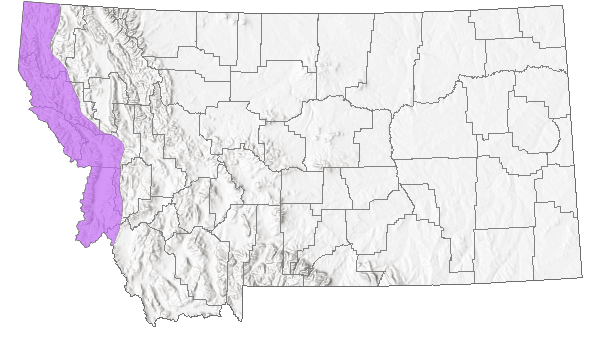
 Native
Native
Range Comments
Endemic to northern ID and adjacent BC and MT (Lesica et al. 2012).
(Contribution of Lesica et al. adapted from Lesica et al. 2012. Manual of Montana Vascular Plants. BRIT Press. Fort Worth, TX).
Observations in Montana Natural Heritage Program Database
Number of Observations: 59
(Click on the following maps and charts to see full sized version)
Map Help and Descriptions
Relative Density
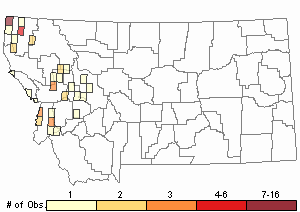
Recency
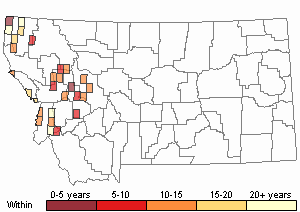
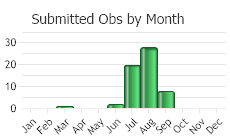
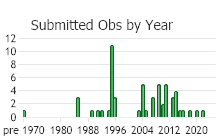
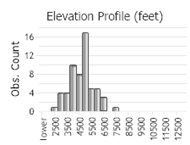 (Observations spanning multiple months or years are excluded from time charts)
(Observations spanning multiple months or years are excluded from time charts)
Habitat
Moist forest and streambanks in montane zones (Lesica et al. 2012). Specimens collected in Montana have been found in moist spruce-fir forest, on a southwest slope at Snowbowl Ski Area, and in subalpine forests, at or above 4000 feet (CPNWH 2017).
(Contribution of Lesica et al. adapted from
Lesica et al. 2012. Manual of Montana Vascular Plants. BRIT Press. Fort Worth, TX).
National Vegetation Classification System Groups Associated with this Species
Forest and Woodland
Montane - Subalpine Forest and Woodland
Wetland and Riparian
Riparian and Wetland Forest
Ecology
This plant is rated as facultative-wet (FACW) in the Arid West and Western Mountains, Valleys, and Coast regions by the US Army Corps of Engineers, meaning that it is usually but not always found in wetlands (Lesica and Husby 2015). It tolerates only slight disturbances, and grows in a somewhat narrow spectrum of ecological conditions (Pipp 2015).
A one-year study conducted in Colorado on a related species,
Ligusticum porteri, found higher numbers and coverage of flowering plants in meadows than in the adjacent forest (Kindscher et al. 2017).
POLLINATORS The following animal species have been reported as pollinators of this plant species or its genus where their geographic ranges overlap:
Bombus occidentalis (Pyke et al. 2012).
Reproductive Characteristics
Fruit: Mericarps (sections of the fruit) are 4-6 mm long with narrow marginal and dorsal wings (Lesica et al. 2012); and a low, cone-shaped stylopodium (Coulter and Rose 1902).
(Contribution of Lesica et al. adapted from
Lesica et al. 2012. Manual of Montana Vascular Plants. BRIT Press. Fort Worth, TX).
Management
The Salish Native Americans of western Montana used the roots of the more-common L. canbyi to treat sore throats (Hart 1979). Western species of Ligusticum are sold as herbal medicines for respiratory ailments (Applequist 2005).
A study in Colorado on a related plant found that most reproduction in one year after root harvesting was from underground vegetative propagation, rather than from seeds (Kindscher et al 2017). That species has not responded well to cultivation (Applequist 2005).
Stewardship Responsibility
Threats or Limiting Factors
STATE THREAT SCORE REASON
Threat impact not assigned because threats are not known (MTNHP Threat Assessment 2021).
References
- Literature Cited AboveLegend:
 View Online Publication
View Online Publication Applequist, W. 2005. Root Anatomy of Ligusticum Species (Apiaceae) Sold as Osha Compared to That of Potential Contaminants. Journal of Herbs, Spices and Medicinal Plants 11(3):1-11.
Applequist, W. 2005. Root Anatomy of Ligusticum Species (Apiaceae) Sold as Osha Compared to That of Potential Contaminants. Journal of Herbs, Spices and Medicinal Plants 11(3):1-11. Consortium of Pacific Northwest Herbaria (CPNWH) Specimen Database. No Date. Plant specimen data displayed on the PNW Herbaria portal. Website http://www.pnwherbaria.org.
Consortium of Pacific Northwest Herbaria (CPNWH) Specimen Database. No Date. Plant specimen data displayed on the PNW Herbaria portal. Website http://www.pnwherbaria.org. Coulter, J. and J. Rose. 1902. Monograph of the North American Umbelliferae. Contributions from the U.S. National Herbarium 7:9-256.
Coulter, J. and J. Rose. 1902. Monograph of the North American Umbelliferae. Contributions from the U.S. National Herbarium 7:9-256. Hart, J. 1979. The Ethnobotany of the Flathead Indians of Western Montana. Botanical Museum Leaflets, Harvard University 27(10):261-307.
Hart, J. 1979. The Ethnobotany of the Flathead Indians of Western Montana. Botanical Museum Leaflets, Harvard University 27(10):261-307. Hitchcock, C. L., A. Cronquist, M. Ownbey, and J. W. Thompson. 1961. Vascular Plants of the Pacific Northwest, Part 3. Saxifragaceae to Ericaceae. Seattle, WA and London, England: University of Washington. 614 pp.
Hitchcock, C. L., A. Cronquist, M. Ownbey, and J. W. Thompson. 1961. Vascular Plants of the Pacific Northwest, Part 3. Saxifragaceae to Ericaceae. Seattle, WA and London, England: University of Washington. 614 pp. Kindscher, K., L. Martin, Q. Long, R. Craft, H. Loring, M. Sharaf, and J. Yang. 2017. Harvesting and Recolonization of Wild Population of Osha (Ligusticum porteri) in Southern Colorado. Nature Areas Journal 37(2):178-187.
Kindscher, K., L. Martin, Q. Long, R. Craft, H. Loring, M. Sharaf, and J. Yang. 2017. Harvesting and Recolonization of Wild Population of Osha (Ligusticum porteri) in Southern Colorado. Nature Areas Journal 37(2):178-187. Lesica, P. and P. Husby. 2015. Field Guide to Montana's Wetland Vascular Plants, second ed. Helena: Montana Department of Environmental Quality Wetland Program. 119 p.
Lesica, P. and P. Husby. 2015. Field Guide to Montana's Wetland Vascular Plants, second ed. Helena: Montana Department of Environmental Quality Wetland Program. 119 p. Lesica, P., M.T. Lavin, and P.F. Stickney. 2012. Manual of Montana Vascular Plants. Fort Worth, TX: BRIT Press. viii + 771 p.
Lesica, P., M.T. Lavin, and P.F. Stickney. 2012. Manual of Montana Vascular Plants. Fort Worth, TX: BRIT Press. viii + 771 p. MTNHP Threat Assessment. 2021. State Threat Score Assignment and Assessment of Reported Threats from 2006 to 2021 for State-listed Vascular Plants. Botany Program, Montana Natural Heritage Program, Helena, Montana.
MTNHP Threat Assessment. 2021. State Threat Score Assignment and Assessment of Reported Threats from 2006 to 2021 for State-listed Vascular Plants. Botany Program, Montana Natural Heritage Program, Helena, Montana. Patterson, P. A., K. E. Neiman and J. R. Tonn. 1985. Field guide to forest plants of northern Idaho. USDA, FS, IRS, Ogden. Gen. Tech. Rpt. INT-180, Ap. 1985.
Patterson, P. A., K. E. Neiman and J. R. Tonn. 1985. Field guide to forest plants of northern Idaho. USDA, FS, IRS, Ogden. Gen. Tech. Rpt. INT-180, Ap. 1985. Pipp, A. 2015. Coefficient of Conservatism Rankings for the Flora of Montana: Part I. Report to the Montana Department of Environmental Quality, Helena, Montana. Prepared by the Montana Natural Heritage Program, Helena, Montana. 73 pp.
Pipp, A. 2015. Coefficient of Conservatism Rankings for the Flora of Montana: Part I. Report to the Montana Department of Environmental Quality, Helena, Montana. Prepared by the Montana Natural Heritage Program, Helena, Montana. 73 pp. Pyke, G.H., D.W. Inouye, and J.D. Thomson. 2012. Local geographic distributions of bumble bees near Crested Butte, Colorado: competition and community structure revisited. Environmental Entomology 41(6): 1332-1349.
Pyke, G.H., D.W. Inouye, and J.D. Thomson. 2012. Local geographic distributions of bumble bees near Crested Butte, Colorado: competition and community structure revisited. Environmental Entomology 41(6): 1332-1349.
- Additional ReferencesLegend:
 View Online Publication
View Online Publication
Do you know of a citation we're missing? Lesica, P., M.T. Lavin, and P.F. Stickney. 2022. Manual of Montana Vascular Plants, Second Edition. Fort Worth, TX: BRIT Press. viii + 779 p.
Lesica, P., M.T. Lavin, and P.F. Stickney. 2022. Manual of Montana Vascular Plants, Second Edition. Fort Worth, TX: BRIT Press. viii + 779 p.
- Web Search Engines for Articles on "Idaho Lovage"





